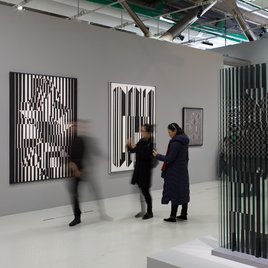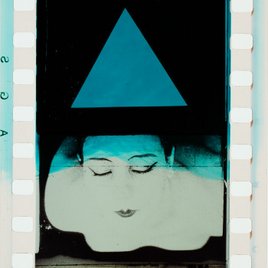Who You Staring At?
Visual culture of the no wave scene in the 1970s and 1980s
February 1 – June 19, 2023
Film, Video, Sound and Digital Collections consultation room
Museum, level 4
Introduction
No wave was a new artistic scene that appeared in the low-rent areas of Lower Manhattan, in New York in 1978. The failure of the hippy cultural and economic model at the very end of the 1960s, then the commercial transformations of new wave and disco, pushed the leading players in the movement to break with the established music industry and contemporary art circles.
Coming from a variety of artistic fields, no wave bands appropriated the instruments of the rock scene, to better turn them against it in order to subvert its icons. Out-of-tune guitars, deconstructed rhythms and raucous vocals enriched a range of radical visual productions, revealing an alternative cultural project blending many media: posters, cassettes and audio records, film and video. Saturated and dissonant sounds were translated into abrasive images that were altered by subverting reprographic techniques (Xerox art), as used in punk and industrial music networks as early as the mid-1970s.
This presentation borrows its title from Who You Staring At?, an album by John Giorno and Glenn Branca. A question that transcribes no wave artists’ confrontational attitude and determination to deconstruct the conventional gaze, presented here in an ensemble of multidisciplinary practices where dance, opera, music and the visual arts intersect.
The activities of no wave groups defined the limits of a zone, the Lower East Side and Tribeca in the late 1970s, where urban decline provided a veritable open-air laboratory for a new generation of musicians, filmmakers, visual artists and performers, whose collaborative work quickly came to constitute the heart of the scene.
Before being struck by the ravages of AIDS, this zone in south-east Manhattan expressed its difference from the sphere of art galleries in the neighbouring SoHo district. These two worlds nevertheless rubbed shoulders in Artists Space which, in May 1978, hosted the groups Daily Life, DNA, Contortions, Mars, Teenage Jesus and the Jerks, Theoretical Girls, Tone Death and The Gynecologists, for a series of no wave concerts. Newly arrived in New York, Brian Eno attended this five-day festival, discovering a post-punk movement that he documented that same year by releasing the compositions of some of these artists on the compilation LP entitled No New York. A compilation that marked a dialogue between "high" and "low" culture, also found at the same time in the music programme that Rhys Chatham curated for The Kitchen, beginning in 1971 – the musician will compose a few years later the sound piece of the no wave ballet Drastic-Classicism (1981) for the choreographer Karole Armitage. This complicity between art and music then developed as early as 1980 in the ABC No Rio multi-disciplinary centre.
The following year, the "Noise Fest" created by Thurston Moore and Josh Baer for the White Columns alternative venue featured the first public performance by Sonic Youth, along with contributions by Glenn Branca, Mark Cunningham and Y Pants. An exhibition designed by musicians Kim Gordon and Barbara Ess accompanied these concerts, notably showcasing the works of Robert Longo, Nina Canal, Alan Vega and Ikue Mori. In the same vein as these events, Christian Marclay invited other major figures from the scene for his "Eventworks" festival (Boston, 1980).
Shown on this occasion, films by Eric Mitchell and Vivienne Dick also testified to the existence of a no wave cinema, which emerged in New York clubs and screening rooms such as the Millennium Film Workshop, The Collective For Living Cinema and the Bleecker Street Cinema, showing works by Amos Poe, James Nares, Beth B and Scott B. These experiences paved the way for Nick Zedd’s and Richard Kern’s "Cinema of Transgression", notably embodied by Kembra Pfahler and Lydia Lunch.
The vibrancy and diversity of this scene, passed on by Glenn O’Brien’s "TV Party" television programme between 1978 and 1982, revealed the project of a visual and sound "compulsion". The title of a piece composed by the group Mars in 1977, this brief and incisive term indicates a unique gesture, a visceral reaction to the dominant musical and artistic trends that characterised no wave’s subversive dimension.
Artworks in the exhibition
Works from the Centre Pompidou collection:
- Dan Graham, Glenn Branca, Performance and Stage-Set Utilizing Two-Way Mirror and Video Time Delay, 1983, video
- Raymond Pettibon, The Whole World is Watching: Weatherman ‘69, 1989, video
- Ida Applebroog, Beth B, Belladona, 1989, video
- Barbara Ess, Sans titre, 1989, monochrome chromogenic print, pinhole camera
- Raymond Pettibon, Sans titre (Grounded?! Never Been), 1998, ink on paper
- Raymond Pettibon, Sans titre (Reagan lays a golden egg!), 1991, Indian ink, wash and red ink on paper
- Raymond Pettibon, Sans titre (Heavily into Masturbation), 1986, ink on paper
Other artwoks shown:
- Vivienne Dick, Guérillère Talks, 1978, digitized Super 8 film. Collection Vivienne Dick et LUX, Londres
- Karole Armitage, Rhys Chatham, Drastic-Classicism, 1981, video. Collection Karole Armitage et Rhys Chatham
- Beth B, Scott B, Letters to Dad, 1979, digitized Super 8 film. Collection Beth B et Scott B / Kino Lorber
- Rhys Chatham, Joseph Nechvatal, XS exemplification of XS: The Opera Opus (1984-1986), 2022, sound slideshow. Collection Joseph Nechvatal
- Joseph Nechvatal, Black Spring, 1983-1984, graphite on paper drawing. Collection Joseph Nechvatal
- Joseph Nechvatal, Supreme Court, 1984, graphite on paper drawing. Collection Joseph Nechvatal
- Joseph Nechvatal, It’s Not Funny, 1983, graphite on paper drawing. Collection Joseph Nechvatal
- Joseph Nechvatal, Fuck Death, 1984, graphite on paper drawing. Collection Joseph Nechvatal
- Joseph Nechvatal, Peace The New Sleep, 1985-1986, graphite, photomechanical paper, Masonite. Collection Joseph Nechvatal
Dan Graham, Glenn Branca
Performance and Stage-Set Utilizing Two-Way Mirror and Video Time Delay, 1983
This presentation confronts spectators with their own image in order to subvert the roles usually assigned to the public and the performer. Placed to the left of the public, Glenn Branca, Margaret Dewys and Axel Gross act out a performance before a two-way mirror. Positioned behind the mirror, a television screen with a six-second time delay shows a view of the room filmed with a wide-angle lens placed over the screen. This performance has been the subject of a sound composition, Acoustic Phenomena, a condensed version of which was released in the form of a 45-rpm record for Graham’s "Pavilions" exhibition catalogue at the Berne Kunsthalle in 1983.
Raymond Pettibon
The Whole World is Watching: Weatherman ‘69, 1989
In this full-length film, Pettibon calls into question the counterculture utopia of the 1960s. Continuing on from his graphical work as part of the American punk scene, Raymond Pettibon made this video with Sonic Youth’s Thurston Moore, Kim Gordon and Mike Watt.
Here the musicians embody members of Weather Underground, a New Left anti-imperialist and anti-racist organisation, known as the Weatherman when it was created in 1969. The work documents the fictitious activities of the organisation (readings, music sessions, destroying vinyl records), faced with other actors playing, for example, Jane Fonda and John Lennon.
Ida Applebroog, Beth B
Belladona, 1989
The texts recited by the performers in Belladonna – filmmaker Jonas Mekas, and milliner Judith Solodkin – reveal cases of male violence. The repetition of certain sequences amplifies the horror of the accounts, interspersed with paintings by Ida Applebroog, Beth B’s mother. These declarations come from the testimonies of murderer Joel Steinberg, survivors of the experiments conducted by war criminal Josef Mengele, and studies of clinical cases taken from Freud’s paper entitled A Child is Being Beaten (1919).
The intertwining of these different sources creates new narratives, while the original texts are recited in full at the end of the video.
Sound works from the New Media Arts collection.
With Kathy Acker, Glenn Branca, Karen Finley, John Giorno, Michael Gira, Richard Hell, Arto Lindsay and Sonic Youth, among other musicians.
Also available in the exhibition:
Reading with Kathy Acker recorded at Centre Pompidou on November 24 1982, as part of Centre Pompidou’s Revue parlée ('Spoken review") – illustrated with photographs by Françoise Janicot.
Related programmes:
- February 1, 2023, 8:00 pm
Opening and performance by musician Rhys Chatham
- As part of the cycle "Vidéo et après":
- February 8, 2023, 7:00 pm, Cinema 2
Sex, Power, and Control: The Art of Beth B. Beth B in conversation with Nicolas Ballet - March 8, 2023, 7:00 pm, Cinema 2
XS: The Opera Opus. An Operatic Transvaluation of No Wave Aesthetics by Joseph Nechvatal and Rhys Chatham - April 28, 2023, 8:00 pm, Museum, level 4
Performance by composer Mark Cunningham. As part of the finissage of the exhibition
- February 8, 2023, 7:00 pm, Cinema 2
- February 9, 2023, 7:30 pm, Cinema L'Archipel
Screening of the documentary Lydia Lunch: The War Is Never Over (2019) by Beth B, in the presence of the director
- February 10 – March 4, 2023, The Film Gallery
Exhibition "Who You Staring At? B-SIDE!"
À lire aussi dans Le Magazine :
No wave : au cœur des contre-cultures new-yorkaises des années 1970-1980
Par Nicolas Ballet
Attaché de conservation, collection nouveaux médias, commissaire de l'accrochage




















